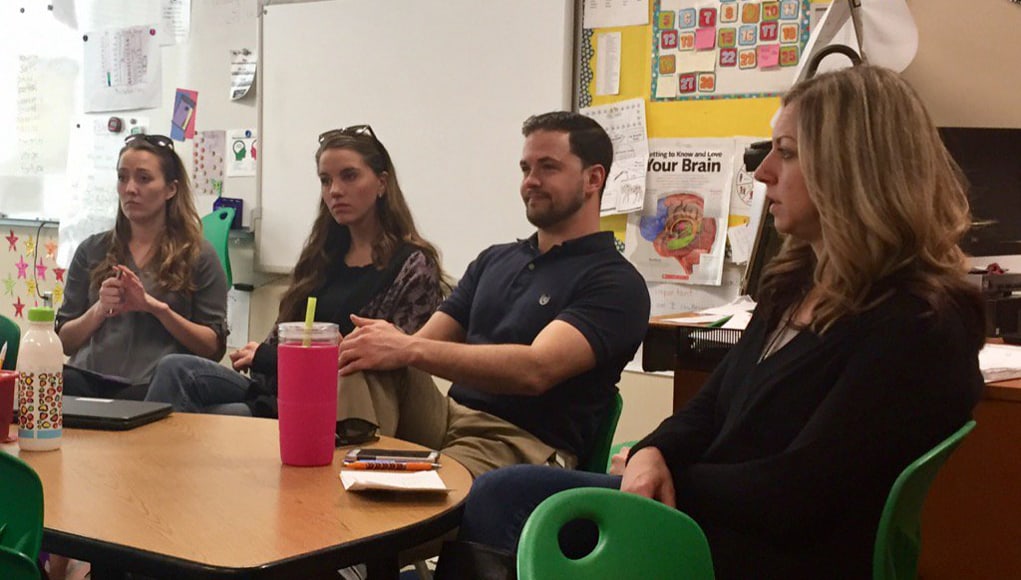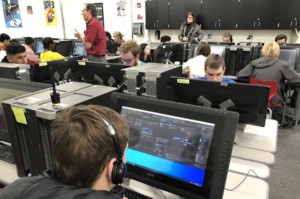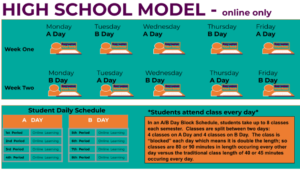The Vision of Performance-Based Education at District 51

A version of this blog ran on CompetencyWorks as the third in a blog series sharing Mesa County Valley School District 51‘s journey as it shifts to a competency-based education model (D51 uses the phrase performance-based learning).
- Do I feel valued, safe and supported in this class?
- What am I learning?
- Why is this important?
- How will I know when I learned it?
It feels a bit like a riddle. You see these four “Guiding Questions” in different places throughout Colorado’s Mesa County Valley School District 51. The district is still in the early stages of ensuring that students can answer all four questions, and seeing them frequently helps remind everyone that this is what they are striving for.
This technique sparks reflection and opens up minds to performance-based learning (also referred to as competency-based learning) and the ultimate goal of personalized learning. These questions go to the heart of what it means to have a transparent system that engages, motivates and enables students to build lifelong learning skills.
They start with the important question ’Do our students feel valued, safe and supported?’ If that isn’t in place, students won’t take risks, they won’t ask for the help they need and they won’t strive to reach their personal best every day.
The Values Leading To The Vision
The D51 team thinks about their efforts toward building a personalized, performance-based system as a transformational journey–transformational in that it is being grounded in a set of very different values. This system is more understanding of learning and capacity than the traditional education system and includes:
- A culture rooted in a growth mindset
- A shared vision
- Transparency and alignment
- Data-driven processes
- Personalized learning
- Collective ownership
What Does it Mean to Be Performance-Based?
Performance-based learning is described at D51 as a systemic framework that starts with a transparency of expectations and is designed to create high levels of reliability in learning. Personalization is rooted within the entire system design and system-building, however they have placed personalized learning as a later phase in implementation.
In order to understand the reasoning behind this, let’s look at their description of personalization. At D51, the core of personalized learning is schools helping students learn how to take responsibility for their own learning. Thus, D51 is working to “embrace a culture where each student has ownership of his/her academic, social and emotional learning resulting in readiness for success in life.”
As a feature of the transformational process, personalization is also about embracing the idea that in order to engage all learners, we need to understand where they are starting from, including the social and emotional aspects of their learning. The entire implementation strategy is shaped by this feature of personalization.
The Elements of Performance-Based Structure
D51 is also in the middle of designing the elements of the performance-based structure, or the points of intersection and alignment that need to be managed to create a transparent, coherent system. These elements include:
- Graduate Profile: Defines graduate competencies, school design and learning experiences. Great Schools Partnership, through a partnership with Colorado Education Initiative, has been helpful in shaping the profiles.
- Shared Vision, Mission and Guiding Principles: Helps make decisions and allocate resources from school board to classroom.
- Teaching & Learning Framework: Guides policies, professional learning and feedback loops to teachers, as well as new capacities and functionality in the system. It includes a set of core effective practices that enable students to take ownership and teachers to create the capacity for personalization in their classrooms.
- Competency Framework: The graduate competencies, standards and rubrics create transparency for what students should know and be able to do at each performance level. In addition, it serves as the structure by which teachers can calibrate proficiency and ensure alignment of instruction and assessment to levels of rigor.
- Growth Mindset and Social & Emotional Learning (including Habits of Mind) Standards and continuum used to help students build the skills needed to become a lifelong learner.
In The Classroom
Teachers who are working to create more learner-driven classrooms are likely to describe performance-based learning as a set of practices, especially given where they are in their implementation and what they have been exposed to. The goal is to create learner-centered classrooms that include:
- A growth mindset culture
- A vision that defines and stretches the learning environment
- Student-created norms
- Transparency of expectations
- Personal goal setting for behavior and academics
- Behavior expectations that are taught and growth that is celebrated
- Systems in place to support self-directed learning
- Infused choices for students within their learning
- Structures to support student voice
- Feedback loops
The current emphasis of the professional learning environment is on these effective practices:
- Culture (Social & Emotional Learning and Growth Mindset)
- Learner-Centered Environment (Backward by Design, Shared Vision & Code of Cooperation, and Workshop); and
- Transparency (Assessment for Learning & Rubrics).
Once the performance-based learning structure is designed, there will be much more transparency, and demand for high reliability will increase and require additional Design Labs.
As we walked through classrooms together, Principal Lea Kreuter of Lincoln Mesa Orchard Elementary described what she looks for in the classrooms given their stage of development. She said, “In addition to evidence of teachers and students using a growth mindset, I am looking for engagement of students in the classroom. I want to see students talking more and teachers talking less, a gradual release of responsibility and teachers leveraging the time and learning experiences in the classroom.”
During another school visit, a teacher at New Emerson Elementary explained that she is seeing immediate value in some of the effective practices. “Unpacking the standards helps students see the end point,” she said. “By increasing transparency, it increases drive.”
Rebecca Midles, Executive Director of Performance-Based Systems at D51, explains that just as we all shift between a fixed mindset and a growth mindset, students will also flow through different levels of dependence and self-directedness. What she hopes is that teachers will be skilled in four of the instructional techniques based on where students are in the continuum of engagement so that students are building the skills they need for self-directed learning after high school.
D51 is in the midst of an enormous process of designing while also providing support to teachers and principals in the demonstration schools. The actual model D51 will use will become much clearer after the Teaching and Learning Framework is complete.
A version of this blog ran on CompetencyWorks as part of the Designing Performance-Based Learning at D51 series.
For more, see:
- Growing Into The Framework: A District’s CBE Implementation Strategy
- Building Community Consensus for District Change
- Getting Smart Podcast | District 51 On Building a Performance-Based Education System
Stay in-the-know with all things EdTech and innovations in learning by signing up to receive the weekly Smart Update. This post includes mentions of a Getting Smart partner. For a full list of partners, affiliate organizations and all other disclosures please see our Partner page.






0 Comments
Leave a Comment
Your email address will not be published. All fields are required.